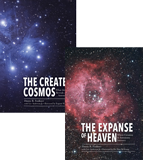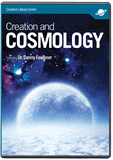
The Book of Enoch and the Flat Earth
Abstract
The Book of Enoch is an important source for those who promote the notion that the earth is flat. A few portions of this rather long book teach that the earth is flat, but other passages are ambiguous about the earth’s shape. Flat earthers are selective about which portions of the Book of Enoch that they cite, because other passages clearly contradict aspects of the flat-earth model promoted today. The book of Enoch almost certainly is pseudepigraphal because there is considerable doubt that the patriarch Enoch wrote it, despite the claim within the book that he did. The Book of Enoch is not canonical. Therefore, it ought not be used to interpret Scripture, particularly in claiming the Bible teaches that the earth is flat.
At-a-Glance
- The Book of Enoch is pseudepigraphal.
- The Book of Enoch is not canonical.
- The Book of Enoch should not be used to interpret Scripture.
- A few parts of the Book of Enoch teach that the earth is flat.
- Many details of the cosmology of the Book of Enoch contradict the modern flat-earth model.
Introduction
In a previous article, I discussed a few of the biblical passages that, according to some people, teach that the earth is flat. There I made the point that the Bible doesn’t endorse any cosmology, but instead gives only bare details regarding cosmology that could be understood several ways. For instance, Genesis 1:1 states that in the beginning God created heaven and earth. The Day Two account (Genesis 1:6–8) tells us that God made the rāqîa (firmament or expanse or sky), and that God called it “heaven.” On Day Four (Genesis 1:16–19), God made the luminaries (astronomical bodies) that he placed in the rāqîa. These statements briefly describe God’s creative acts during Creation Week, but they hardly teach any particular cosmology, such as geocentrism or heliocentrism, whether the earth is flat or a sphere, or whether the universe is expanding or static. God exemplified his wisdom in not endorsing any of man’s cosmologies in his Word. If God had done otherwise, it would have needlessly exposed the Bible to ridicule in nearly every age, for man’s cosmologies have changed continually over time.
Nevertheless, throughout the ages, people have chosen to understand these verses from the creation account, as well as other verses throughout the Bible, in terms of the cosmology of their day. Examples include the Septuagint’s translation of rāqîa as stereoma, and Thomas Aquinas’ endorsement of the Ptolemaic model. The first example ultimately led to the poor translation of rāqîa as “firmament,” which in turn led to much confusion (including flat-earth movement today). The second example resulted in the Galileo affair. Even today we live with the consequences of both mistakes. This should be a lesson to all of us not to read into Scripture (eisegesis) our preferred cosmology. However, flat-earthers have failed to learn this lesson, because they insist that their understanding of biblical passages teach that the earth is flat.
Where do flat-earthers get this notion? Contrary to common misconception, for the two millennia of the Christian age, the church did not teach that the earth is flat. Depictions of an enclosed dome over a flat earth (Figure 1) supposedly taught in the Bible did not start appearing until the 19th century. But it was Bible critics, not Christians, who introduced these diagrams. Only in recent decades have Christians fallen for this lame attack on the authority of Scripture and foolishly begun reproducing these figures as if this is what the Bible taught all along. Unfortunately, some Christians of late have swallowed this faux history (and much more false history) and begun proclaiming flat earth as truth in a misguided attempt to defend the Bible.
The Book of Enoch
Some flat-earthers have appealed to the Book of Enoch to support their argument that the Bible teaches that the earth is flat. What is the Book of Enoch? As the name suggests, this ancient book (sometimes referred to as 1 Enoch) ostensibly was penned by Enoch, the great-grandfather of Noah. However, most scholars believe the Book of Enoch was written in the second and first centuries BC, not three millennia earlier when Enoch most likely lived. Therefore, the book is pseudepigraphal. Neither Jews nor Christians have considered the Book of Enoch to be part of the canon, though some smaller sects (especially in Ethiopia) have given it some status. To the non-Christian, the Book of Enoch is just another ancient manuscript, on par with the Bible. However, to the Christian, the Book of Enoch is in a totally different category from Scripture, though it may be of some value as a window to what some ancient Jews thought. Some Christians who teach that the earth is flat try to split the difference, treating the Book of Enoch as a sort of commentary on the Bible. But the Book of Enoch doesn’t claim to be a commentary, but instead comes across as a revelation, at least implying the claim that it is an inspired text.
Several defenses are put forth for holding the Book of Enoch in such high regard. One defense is that it was included with the Qumran scrolls. However, all this proves is that for whatever reasons, the Qumran sect liked it. Another defense is that the NT writer Jude (vv. 14–15) quoted from it. But this quote is only one sentence from a very lengthy book. Nor is the Book of Enoch alone in being quoted in the New Testament. In Titus 1:12, the Apostle Paul quoted a single line from Epimenides, a sixth-century BC Greek poet. In Acts 17:28 Paul also quoted from Epimenides, as well as Aratus, a third-century BC Greek poet. Clearly, the mere quotation of a single line from ancient extrabiblical sources does not impart special status to those texts to interpret Scripture.
Does the Book of Enoch teach that the earth is flat? Let us examine some of its passages that supposedly do. I will quote from M. Knibb’s translation, with notes by Andy McCracken. Enoch 18:1–5 reads,
And I saw the storehouses of all the winds, and I saw how with them He has adorned all creation, and I saw the foundations of the Earth.
And I saw the cornerstone of the Earth. And I saw the four winds which support the Earth and the sky.
And I saw how the winds stretch out the height of Heaven, and how they position themselves between Heaven and Earth; they are the Pillars of Heaven.
And I saw the winds which turn the sky and cause the disc of the Sun and all the stars to set.
And I saw the winds on the Earth which support the clouds and I saw the paths of the Angels. I saw at the end of the Earth; the firmament of Heaven above.
This passage contains some words and phrases that are found in the Bible, such as “four winds,” and “foundations of the earth,” albeit put together a little differently, and with additional information. For instance, the phrase “disc of the sun” appears nowhere in the Bible. One could read the last verse quoted above as the firmament (dome, if one insists that is what “firmament” means) resting upon the “ends of the earth,” which is consistent with the flat-earth model promoted today. Or perhaps not. The meaning is ambiguous. This passage conveys some information that most flat-earthers would disagree with. For instance, it attributes the motion of the sun and the stars across the sky to winds. Do flat-earthers today believe this? I have yet to encounter that claim in material promoting the flat earth. This passage credits the winds with stretching out the height of heaven, and it identifies the winds as the pillars of heaven. Again, I have yet to encounter this teaching in flat-earth material. The phrase “pillars of heaven” appears once in the Bible. Job 26:11 reads,
The pillars of heaven tremble
and are astounded at his rebuke.
Forget what the Book of Enoch says—what are the pillars of heaven in Job 26:11? That isn’t clear at all. First, note that God isn’t speaking in Job 26, but rather it is the beginning of Job’s long response (Job 26–31) to Bildad’s comments in Job 25. Therefore, the thoughts expressed here are those of Job’s, and may not necessarily reflect God’s truth. Furthermore, since Job is a poetic book, we ought to be very careful about reading this too literally. The trembling here may refer to physical shaking (some commentators think the pillars here refers to mountains, which certainly appear to hold up the sky), so one could argue that this refers to some physical shaking, such as an earthquake. But what about the second part of this verse? It says the pillars of heaven are astounded at his (God’s) rebuke. Can inanimate objects be astounded? Obviously not, so perhaps the trembling in the first part of the verse does not refer to literal trembling. Carefully note that I am not saying that because one part of one verse in Scripture is nonliteral that we are free to assert a nonliteral interpretation anywhere else in the Bible as we please. Rather, the tight structure of individual verses, with the hallmark parallelism and contrasts found within a single verse in ancient Hebrew poetry, indicates looking at the entire verse coherently. To argue that part of a single verse in Hebrew poetry is to be taken very literally, while its parallel expression is not, is to destroy this characteristic of ancient Hebrew poetry. Returning to this passage in the Book of Enoch, it contains enough poetic elements to warrant questioning whether any of this passage teaches that the earth is flat.
Continuing, Enoch 18:6–12 reads,
And I went towards the south, and it was burning day and night, where there were seven mountains of precious stones, three towards the east and three towards the south.
And those towards the east were of coloured stone, and one was of pearl, and one of healing stone; and those towards the south, of red stone.
And the middle one reached to Heaven, like the throne of the Lord, of stibium, and the top of the throne was of sapphire.
And I saw a burning fire, and what was in all the mountains.
And I saw a place there, beyond the great earth; there the waters gathered together.
And I saw a deep chasm of the earth, with pillars of heavenly fire, and I saw among them fiery pillars of Heaven, which were falling, and as regards both height and depth, they were immeasurable.
And beyond this chasm, I saw a place, and it had neither the sky above it, nor the foundation of earth below it; there was no water on it, and no birds, but it was a desert place.
The last verse is interesting. Similarly, Enoch 21:1–2 reads:
And I went round to a place where nothing was made.
And I saw a terrible thing, neither the High Heaven nor the firm ground, but a desert place, prepared and terrible.
Apparently, flat-earthers interpret these two passages as referring to what lies beyond the dome that covers the earth. I don’t know what to make of these verses. But then, I don’t have to worry about that, because I don’t consider the Book of Enoch to be authoritative. Nor should we be bound to interpret Scripture in terms of an interpretation of these few verses in the Book of Enoch.
Enoch 33:1–2 reads,
And from there I went to the ends of the earth, and I saw there large animals, each different from the other, and also birds, which differed in form, beauty, and call—each different from the other.
And to the east of these animals, I saw the ends of the Earth, on which Heaven rests, and the open Gates of Heaven.
Unlike the passage discussed above, this passage from the Book of Enoch does appear to teach a cosmology akin to that of 21st century flat-earthers, for it speaks of heaven resting on the ends of the earth.
Enoch 72:1–4 reads,
The Book of the Revolutions of the Lights of Heaven. Each as it is; according to their classes, according to their period of rule and their times, according to their names and places of origin, and according to their months. That Uriel, the Holy Angel who was with me, and is their leader, showed to me. And he showed me all their regulations, exactly as they are, for each year of the world and for ever, until the new creation shall be made which will last forever.
And this is the First Law of the Lights. The light called the Sun; its rising is in the Gates of Heaven that are towards the east, and its setting is in the western Gates of Heaven.
And I saw six Gates from which the Sun rises, and six Gates in which the Sun sets, and the Moon also rises and sets in those Gates, and the leaders of the stars together with those whom they lead. There are six in the east and six in the west, all exactly in place, one next to the other; and there are many windows to the south and the north of those Gates.
And first there rises the greater light, named the Sun, and its disc is like the disc of Heaven, and the whole of it is full of a fire which gives light and warmth.
Flat-earthers may prefer an older translation of the Book of Enoch, where in the last verse above, rather than “disc,” it is translated “circumference.” For them, this is close enough to the word “circuit,” as it appears in Psalm 19:4b–6,
In them he has set a tent for the sun,
which comes out like a bridegroom leaving his chamber,
and, like a strong man, runs its course with joy.Its rising is from the end of the heavens,
and its circuit to the end of them,
and there is nothing hidden from its heat.
Some flat-earthers assume that the psalmist David had read the Book of Enoch and go on to suggest that Psalm 19 may be an echo of the Book of Enoch. Never mind that the Book of Enoch was written nearly a thousand years after David lived. It is far more likely that the writer(s) of the Book of Enoch echoed Psalm 19 here. Enoch 74 contains a similar description of the moon and its motion. These discussions of the sun and moon, as well as the sun’s description in Psalm 19, are interpreted in terms of the flat-earth model as clearly teaching the earth is flat. But do they? They are vague enough to be interpreted in terms of a geocentric spherical earth. Indeed, geocentrists have made this argument about Psalm 19 for years, long before the recent rise of the flat-earth phenomenon. And those who believe in a spherical earth in a heliocentric cosmology have too. So does the Book of Enoch teach that the earth is flat? Enoch 21 and Enoch 33 appear to do so, though the other passages often claimed do not so clearly make that case.
Parts of the Book of Enoch Flat-Earthers Don’t Talk About
However, flat-earthers who use the Book of Enoch in support of their cosmology are selective in what the Book of Enoch teaches. For instance, most flat-earthers claim that the sun neither rises nor sets. Rather, they claim, the sun only appears to set as a matter of perspective. Indeed, if the sky merely spins about the center of a round, flat earth (the North Pole) as flat-earthers maintain, then the sun is continually above the horizon. Flat earthers insist that the sun ceases to shine for us at night, because the sun is a downward directed spotlight. When the sun moves far enough away that we are no longer in the spotlight, it gets dark. Besides the fact that this explanation doesn’t really work, there is a problem related to the Book of Enoch on this matter. You see, the Book of Enoch describes the sun rising through a gate, or portal, in the east in the morning and setting through another gate in the west in the evening. Above I quoted Enoch 72:1-4, but consider the next verse, Enoch 72:5,
The wind blows the chariots on which it ascends, and the Sun goes down in the sky and returns through the north in order to reach the east, and is led so that it comes to the appropriate Gate and shines in the sky.
That is, the sun passes below the horizon in the west, loops under the northern horizon, and then rises in the east the next morning. This explanation is repeated in Enoch 78:5. Apart from the gates, this description is very similar to the conventional (spherical earth) explanation of the sun’s daily motion in the sky. Enoch 72 says that there are six gates from which the sun rises and six gates in which it sets. Which gates the sun uses depends upon the time of year, as the azimuth of the rising and setting sun changes seasonally. The moon rises and sets through the same gates. Enoch 36 describes special gates in the eastern sky that the sun rises through, as well as many smaller gates that the stars rise through. Enoch 33:3 similarly details the rising of the stars:
And I saw how the stars of Heaven come out, and counted the Gates out of which they come, and wrote down all their outlets, for each one, individually, according to their number. And their names, according to their constellations, their positions, their times, and their months, as the Angel Uriel, who was with me, showed me.
None of this conforms to the flat-earth model in discussion today, because they teach that, like the sun, the moon and stars do not rise or set.
Enoch 33–36 describes twelve gates, three in each of the cardinal directions. Winds blow from each of these gates. Enoch 76 gives more detail of these winds. Four of the winds are good, but eight are bad. I seriously doubt that flat-earthers accept these teachings, altogether ignoring them instead.
But the very existence of these three gates at the edge of the earth in the four cardinal directions is problematic for the modern flat-earth cosmology. The North Pole is at the center of the modern flat-earth model. At the North Pole, all directions are south, so there are no cardinal directions at the North Pole. The only way that gates at the ends of the earth in the four cardinal directions make sense is if the observer (the writer of this portion of the Book of Enoch) is at the earth’s center, which is not at the North Pole. Only then can there be gates at the edge of the earth in each of the four cardinal directions. Gates in the four cardinal directions only make sense if the location of reference is at the earth’s center. However, from other locations on the earth’s surface, those gates would not have the same orientations in the four cardinal directions. Indeed, in answering the question of how people can circumnavigate the earth if it is flat, flat-earthers claim that circumnavigation in one direction (either east or west) makes a circuit around the North Pole. But if one can continually circle the flat earth in either the east or west direction, never reaching the earth’s edge, then neither east nor west intersect the dome at the earth’s edge. Therefore, there can be no gates at the edge of the earth in those directions. Again, the cosmology of the Book of Enoch conflicts with the flat-earth cosmology of today.
At least one other astronomical teaching found in the Book of Enoch clearly contradicts the flat-earth cosmology of today. Enoch 78 talks about light transferring from the sun to the moon. This is consistent with the conventional understanding that the moon shines by reflecting the sun’s light, indicating that the author of this portion of the Book of Enoch properly understood the moon’s light. Indeed, the changing amount of the lit half of the moon that is visible as it orbits the earth with respect to the sun (the synodic month) explains lunar phases. The curved terminator (the division between light and dark on the moon) shows that the moon is a sphere. But modern flat-earthers insist the moon is a flat disk, not a sphere. Furthermore, they claim that the moon shines by its own light, not by reflecting the light of the sun. Also notice that flat-earthers don’t offer any explanation for lunar phases. They seem to be confident of what doesn’t cause lunar phases, but they seem to have no curiosity as to the true cause.
Conclusion
Flat-earthers have a peculiar relationship with the Book of Enoch. Non-Christian flat-earthers view the Bible and the Book of Enoch as having equal authority. Christian promoters of flat-earth must do careful choreography to accept the Book of Enoch to the extent of using it to interpret Scripture, while simultaneously giving lip service to the fact that the Book of Enoch falls far short of biblical authority.
Some passages of the Book of Enoch that supposedly teach that the earth is flat are ambiguous. However, a few passages do appear to indicate the writer(s) of the Book of Enoch believed the earth is flat. However, other cosmological details of the Book of Enoch clearly contradict the preferred cosmology of modern flat-earth proponents. This selective reading of the Book of Enoch is misleading at best.
The Book of Enoch often appears in popular literature related to a different subject. Many flat-earth adherents, like Rob Skiba, have used Enoch to promote strange theories about the Nephilim. Some of these authors have written entire books speculating about the Nephilim, and how they might connect to supposed conspiracies in our day. This is strange, considering that this word appears only three times in the OT (once in Genesis 6:4 and twice in Numbers 13:33). Each time, the KJV translates Nephilim as “giants.” Another Hebrew word for giants, rephaim, occurs 25 times in the OT. The KJV translated it 17 times as “giants” or “giant,” depending on whether it was plural or singular (raphe), but in the other eight occurrences, it was transliterated into English. Here is what we are told in Genesis 6:4:
The Nephilim were on the earth in those days, and also afterward, when the sons of God came in to the daughters of man and they bore children to them. These were the mighty men who were of old, the men of renown.
Who were these Nephilim? There are at least three main theories held by evangelical scholars, and Answers in Genesis does not take an official position on this topic. One of these views, known as the Fallen Angel theory, states that fallen angels married human women and had children with them. These offspring were giants, known as the Nephilim. According to this theory, these Nephilim were one of the sources of the wickedness filling the world and leading to the Flood.
The sixth and seventh chapters of the non-inspired Book of Enoch reflect this view and expand upon the strange passage in Genesis 6:1–4, giving many more details about the sons of God and the Nephilim.
Rob Skiba, a prominent promoter of a flat earth, also promotes his own fantastic version of the Nephilim, complete with details of Nephilim in end-time prophecies. This goes far beyond the Fallen Angel view held by many scholars and even the fanciful embellishments in the the Book of Enoch. Most promoters of this theory believe the Nephilim were around 10 feet tall (after all, Hebrew lexicons define the word Nephilim as “giants”). However, Skiba and others who so often rely on the Book of Enoch conveniently leave out one detail about the Nephilim from it. Enoch 7:2 reports that the Nephilim were 3,000 cubits tall (older translations use an archaic term for the cubit, the ell). This would be 4,000–5,000 feet, depending upon the length of the intended cubit. I seriously doubt that anyone today believes the Nephilim were anywhere near this height. But this one detail greatly undermines any idea that all the Book of Enoch is inspired or should be included in the canon. Those who are fans of the Book of Enoch conveniently ignore this fact.
Once on social media, a person commented on one of my flat-earth critiques. This person exclaimed that I probably had never even read the Book of Enoch. My immediate impulse was, “Of course not—I don’t read fiction,” though I didn’t express it at the time. The truth is, I’ve read much of the Book of Enoch, and I’m not impressed. How we came to accept the 66 books of the Bible is not a simple question, and I certainly will not attempt an answer here. Suffice it to say that the Holy Spirit not only inspired biblical authors so that they wrote without error, but he also operated to preserve what they wrote and guided the decisions that led to the canon of Scripture. There were many other ancient texts, including the Book of Enoch, that various people thought ought to have been included, but they did not make the cut. I have identified some of the problems in the Book of Enoch that demonstrate the wisdom of recognizing that it is not canonical from the canon of Scripture. It is sad that some Christians want to accept the teachings of the flawed Book of Enoch, and then use its teachings to falsely interpret the Bible.
Recommended Resources

Answers in Genesis is an apologetics ministry, dedicated to helping Christians defend their faith and proclaim the good news of Jesus Christ.
- Customer Service 800.778.3390
- © 2024 Answers in Genesis





